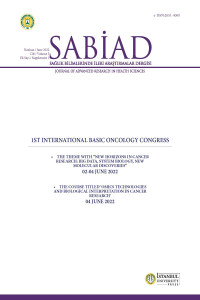NETWORK AND PATHWAY BASED ANALYSIS OF MULTI-OMIC DATA TO ENLIGHTEN MOLECULAR MECHANISMS OF COMPLEX DISEASES
Öz
The tremendous boost in the next generation sequencing technologies and in the “omics” technologies makes it possible to look for the coordinated
behavior among different levels of biochemical activity. Irrespective of the technology used, the advent of high-throughput profiling technologies presents
a new challenge, that of interpretation of these data in a meaningful manner – to uncover relationships that are not readily apparent between molecular
profiles and states of health or disease. In contrast to isolated molecules, network and pathway oriented analyses are thought to better capture
pathological perturbations and hence, better explain predisposition to disease. In this talk, firstly I will introduce different types of multi-omics data
integration methods. Along this line, I will present existing trans-omics, merge-omics, multi-omics, panomics strategies as an example of integrative omics
studies. Secondly, I will focus on network and pathway based integration techniques. In this respect, I will mention different functional enrichment analysis
techniques including over-representation analysis (ORA), gene set enrichment analysis (GSEA) methods, integrative and modular enrichment analysis
(MEA). Thirdly, I will summarize our approach and present how this approach can help us to identify disease-associated pathway markers. Lastly, I will
conclude via discussing how these pathway markers can help us to enlighten individual disease development mechanisms and personalized targets for
treatments, and hence bridging the gap between the -omics data and precision medicine.
Anahtar Kelimeler
multi-omics network and pathway based –omics data analysis functional enrichment
Kaynakça
- Grozescu T, Popa F. Prostate cancer between prognosis and adequate/proper therapy. J Med Life. 2017;10(1):5-12
NETWORK AND PATHWAY BASED ANALYSIS OF MULTI-OMIC DATA TO ENLIGHTEN MOLECULAR MECHANISMS OF COMPLEX DISEASES
Öz
The tremendous boost in the next generation sequencing technologies and in the “omics” technologies makes it possible to look for the coordinated behavior among different levels of biochemical activity. Irrespective of the technology used, the advent of high-throughput profiling technologies presents a new challenge, that of interpretation of these data in a meaningful manner – to uncover relationships that are not readily apparent between molecular profiles and states of health or disease. In contrast to isolated molecules, network and pathway oriented analyses are thought to better capture pathological perturbations and hence, better explain predisposition to disease. In this talk, firstly I will introduce different types of multi-omics data integration methods. Along this line, I will present existing trans-omics, merge-omics, multi-omics, panomics strategies as an example of integrative omics studies. Secondly, I will focus on network and pathway based integration techniques. In this respect, I will mention different functional enrichment analysis techniques including over-representation analysis (ORA), gene set enrichment analysis (GSEA) methods, integrative and modular enrichment analysis (MEA). Thirdly, I will summarize our approach and present how this approach can help us to identify disease-associated pathway markers. Lastly, I will conclude via discussing how these pathway markers can help us to enlighten individual disease development mechanisms and personalized targets for treatments, and hence bridging the gap between the -omics data and precision medicine.
Anahtar Kelimeler
multi-omics network and pathway based –omics data analysis functional enrichment
Kaynakça
- Grozescu T, Popa F. Prostate cancer between prognosis and adequate/proper therapy. J Med Life. 2017;10(1):5-12
Ayrıntılar
| Birincil Dil | İngilizce |
|---|---|
| Konular | Klinik Tıp Bilimleri |
| Bölüm | Toplantı Özeti |
| Yazarlar | |
| Yayımlanma Tarihi | 9 Ağustos 2022 |
| Gönderilme Tarihi | 28 Haziran 2022 |
| Yayımlandığı Sayı | Yıl 2022 Cilt: 5 Sayı: S-1 |


